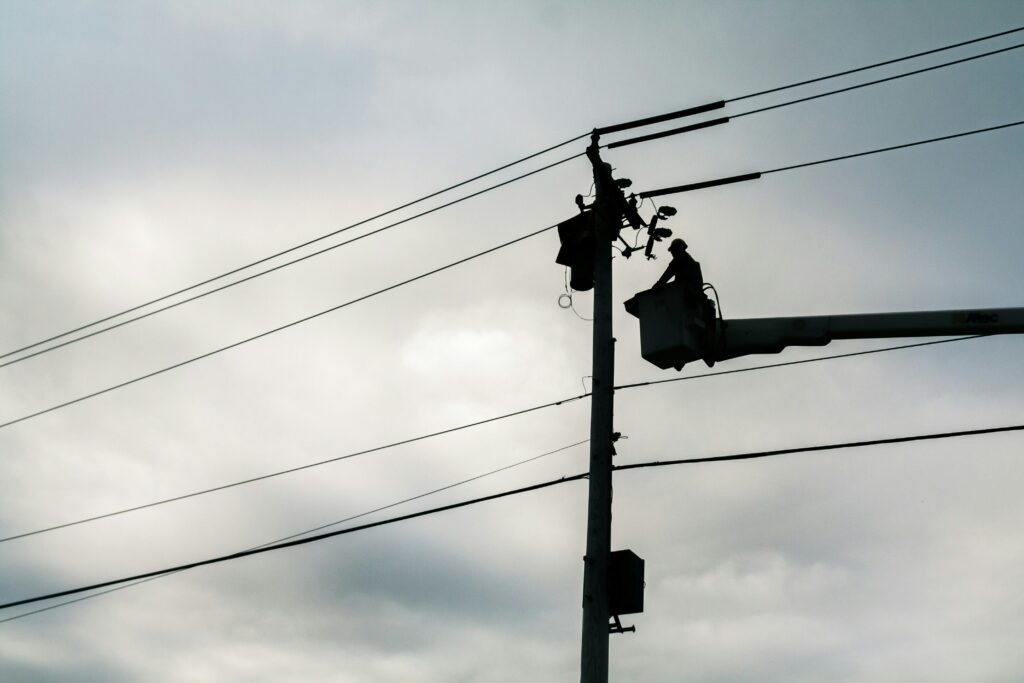Power outages can feel sudden and frustrating: one moment you’re making coffee or watching TV; the next, you’re in the dark. And you’re left wondering, “How long will this outage last?” and “What’s being done to fix it?”
The answer: lineworkers are already on the job. These highly trained professionals respond quickly, often in dangerous or extreme conditions, to find the issue, make repairs, and safely bring your electricity back.
Let’s explore what really happens during a power outage, step by step, and see why lineworkers play such a critical role in keeping our communities powered and connected.
Step 1: Detecting the Outage
Many people are surprised to learn that utilities often know there’s a problem before a single customer picks up the phone. Thanks to advanced technology and sensors in the electrical grid, outages are detected almost instantly. These systems send alerts to utility control centers, showing exactly where something has gone wrong.
In some cases, lineworkers are already being prepped to head out when the neighborhood is only beginning to realize the power is out.
Step 2: Lineworkers Are Dispatched Fast
Once the outage is confirmed, lineworkers are sent out, day or night, rain or shine. They’re trained to move quickly but safely, often with just a minute’s notice.
Whether the issue is from a lightning strike, heavy snow, or a fallen tree, lineworkers show up with everything they need to assess the situation and start the fix.

Step 3: Assessing the Situation
This is where the detective work begins. The first job is figuring out why the power went out. That could be:
- A tree falling on a line
- A blown transformer
- A damaged pole
- Equipment failure
- A car accident hitting a utility pole
Lineworkers patrol the area and inspect power lines, poles, and equipment until they find the issue. In rural areas, that might mean covering miles of land to find the damage. In cities, that might mean working around traffic or other infrastructure in crowded neighborhoods.
Step 4: Making the Area Safe
Before anything gets fixed, lineworkers follow strict safety procedures to protect themselves and the public. That often means shutting off power to the affected lines, setting up barriers around dangerous areas, and gearing up with protective gear to prevent electrical shock or injury.
Safety isn’t optional in this line of work, it’s the foundation of everything they do.
Step 5: Performing Repairs
Once the area is safe, the real work starts. Depending on the problem, lineworkers may need to:
- Replace damaged wires
- Swap out a blown transformer
- Fix or replace a utility pole
- Reconnect lines and test equipment
Every repair has to be done with total precision and requires both physical strength and deep technical knowledge. Lineworkers understand how power flows, how to isolate faults, and how to restore systems without creating new hazards. It’s demanding work, but it’s also incredibly rewarding.
Step 6: Restoring Power
Once the job is done, crews coordinate with the utility’s control center to bring electricity back online. This process is done in phases to make sure everything is stable.
When the lights finally come back on, it’s a moment of pride for lineworkers. Pride that their community is back online and they kept their community safe.
Step 7: Follow-Up and Preventative Fixes
Even after the power is restored, the work isn’t always over. Crews may stay on site to double-check equipment or report other areas that need maintenance. Sometimes, the outage reveals weak spots in the system—things that need to be fixed soon (or now!) to avoid future problems.
Lineworkers aren’t just there to fix the problem, they also help keep it from happening again.
Every time there’s a storm, an accident, or a blown fuse that knocks out power, lineworkers are the ones who gear up and get out there. They climb poles in freezing temperatures, work through the night, and face dangerous conditions to restore what most of us take for granted.
They don’t do it for attention, they do it because they’re proud of their work, they know their community is counting on them, and they thrive on solving real problems in real time.
So the next time the lights flicker and go out, rest assured that lineworkers are on the way, and they won’t rest until the job is done and done well, no matter the conditions.
Interested in becoming one of the people who powers the country? Learn more about the electrical trades and how registered apprenticeship programs can help you begin strong and get started today!
